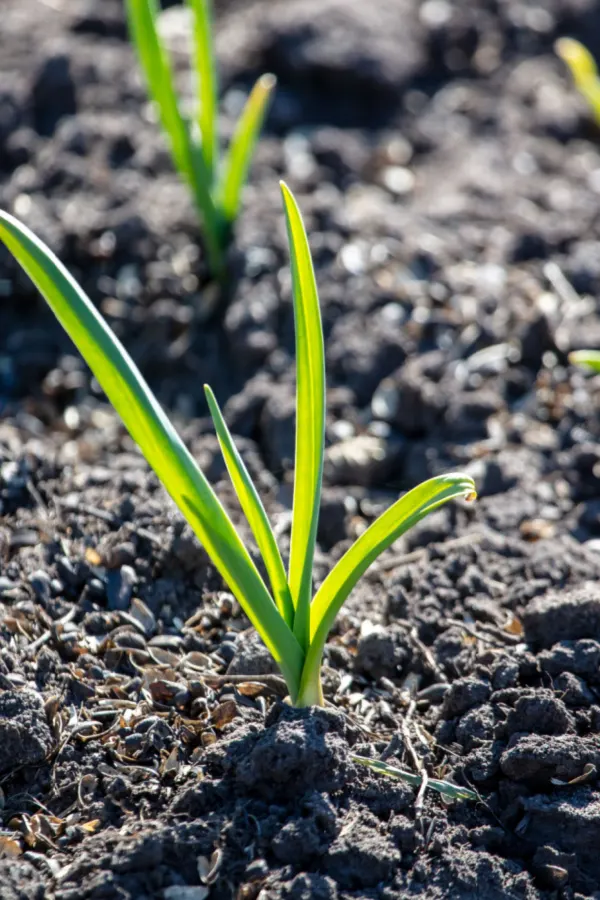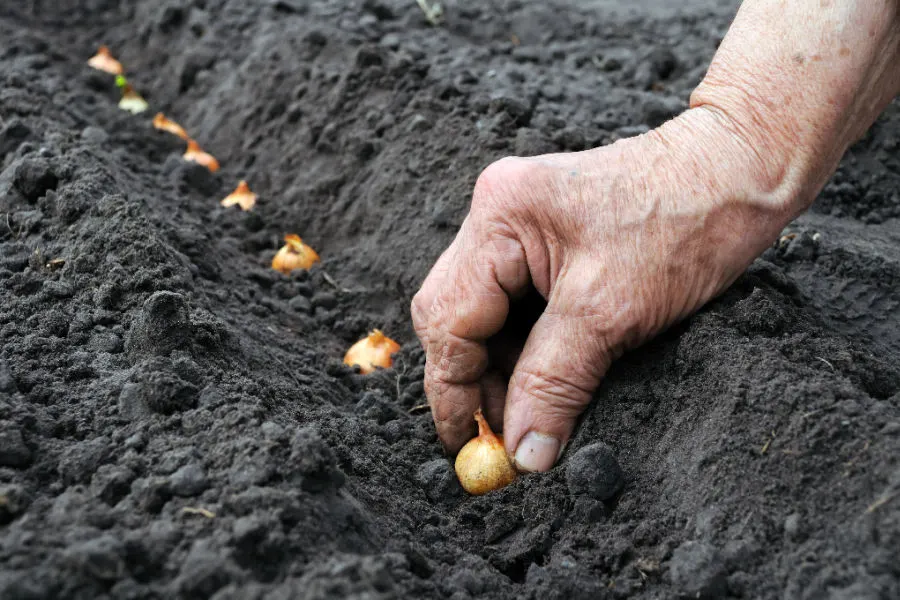If you are looking for a way to grow your biggest and tastiest crop of onions ever – you need to plant your onion crop this fall!
Although many gardeners plant their onion sets in the spring, fall planting is actually one of the best ways to grow larger and more flavorful bulbs. In fact, fall onion planting has a whole slew of advantages over spring planting, and once you try it, you might never plant onions in the spring again!
Planting your onions in early Autumn allows the root vegetable to establish easily in the cooler temperatures of fall. Onions struggle with intense heat. Not only can it slow or even prevent germination, it can also cause serious issues with their long term growth.

By fall, the sun’s rays have become far less intense. In addition, the amount of sunlight diminishes with each passing day. That, coupled with cooler temperatures work wonders for allowing onions to set their roots with ease. This is exactly why planting garlic in the fall is best too! See : How To Plant Fall Garlic
By the time the first frost rolls around, the onions have not only sprouted through the soil, they have also developed a strong network of fibrous roots under the soil. As the cold settles in, the bulbs then go dormant for winter. And does that early growth ever pay off in the spring!
Coming Back To Life In The Spring – How To Plant Fall Onions
A fall planted onion crop will go dormant after a few hard frosts or the first deep freeze. And although they are in a resting phase at this point, this chilling period allows the bulbs to develop more robust and complex flavors while they “sleep” in the ground.
Once spring rolls around, the bulbs and top foliage come back to life. This is a huge advantage over planting bulbs in the spring. Instead of spending the first few weeks in the ground acclimating and setting roots, fall onions are already to go.

Because of that, they simply start again right where they left off! It gives them a big head start over spring-planted onions, making them ready to mature and harvest much faster. But even more, their flavor is light years ahead from being allowed to overwinter and chill in the cool winter soil.
With all of those great advantages in mind, here is a look at how to plant your own amazing fall onion crop this year!
How To Plant Fall Onions
When planting fall onions, the timing of planting all depends on where you live. Onions can usually be planted around the same time you plant fall garlic. Both crops need around 4 to 6 weeks to grow before a hard freeze or heavy frosts set in.
As an example, if you live in an area where November starts to see the true cold winter temperatures arrive, you will want to plant mid-September. This allows enough time for the crop to settle in. If you are unsure of your average freeze and frost dates, your local extension office is always a great resource.
Why Onion Sets Are Best For Fall Planting
When planting in the spring, onions can be planted by seed or with bulbs (onion sets). For fall planting, it is best to always use sets. Why? Onions seeds simply take too long to become established for a fall planting.

If you do choose to try the seed route, you will need to plant at least 8 to 10 weeks before your hard freeze date. Unfortunately, by starting that early, it is usually smack in the middle of the heat of summer – which can make sprouting seed difficult.
Planting Onions With The Trench Method – How To Plant Fall Onions
When planting sets, the trench method works best. Not only is it easy, it gives your onions the best chance of success. Sets can be hard to find in the fall (we have a few links below), but check with your local garden centers early as well to see if they have stock.
To start, dig a two to three inch deep trench in the soil that is about two inches wide. This will allow plenty of space for loose soil that will help the onions to set their roots with ease. Just as with any root crop, the more loose and friable the soil, the better the harvest will be!
Once you have created your trench, fill it up two-thirds full of compost. Compost is a huge key to onion growing success! The rich, fertile compost not only help bulbs germinate quickly, it also provides plenty of nutrients as they grow and settle in.
When planting, always be sure to plant your bulbs with the point end up. This is where the shoots will develop from, and it will help the bulb grow their shoots to the surface fast.
The Power Of Using Compost
As you plant, set each bulb halfway down into the layer of compost. Space the onions approximately four to six inches apart when planting. This allows plenty of room for their roots to grow freely, and allows for easier maintenance between the bulbs.

Once the bulbs are set into the compost, fill in the trench with the remaining soil. When planted, the bulbs should be covered in full with about 1/2 to 3/4 inch of soil. To complete the planting, water the soil on top to help set the bulbs in place and provide them with a bit of moisture.
The Importance of Mulch – How To Plant Fall Onions
One of the most important things you can do to help your crop is to mulch the soil around them! Immediately after planting, mulch the soil with a thin layer of straw or shredded leaves.
Mulch has several big advantages for your crop. For starters, it will help to keep competing weeds at bay. More importantly, it helps keep moisture in the soil to help with the germination process. Keep the mulch light at first to allow the seeds to germinate.
Once seedlings emerge through the ground, you will need to add additional mulch to provide full protection. Be sure to water at least every few days for the first few weeks until established.
As the cold weather approaches, apply a few more inches of straw or shredded leaves to help insulate the crop for the winter. Through winter, your onions should be mulched to a depth of about 4 inches. The onions will go dormant after a few hard frosts or a hard freeze – and remain that way until spring when they begin to grow again.

Spring Onion Growing – How To Plant Fall Onions
Once spring arrives and your onions begin growing again, care is simple. You may need to add a bit of mulch to keep them free of weeds, but other than that – allow the onions to grow to size and harvest as needed.
Fall planted onions can be harvested at any point. They are great as tender “young” onions or when allowed to grow to full size. If your crop does begin to send up flowers, cut these as soon as you see them. It will allow the onions to continue to develop and grow.
Here is to planting a great crop of fall onions this year!
Follow Our Facebook Page For Great Gardening Tips And Advice! This Is My Garden Facebook Page
This Is My Garden is a garden website created by gardeners, for gardeners. Jim and Mary Competti have been writing gardening, DIY and recipe articles and books and speaking for over 15 years from their 46 acre Ohio farm. They publish three articles every week, 52 weeks a year. Sign up today to follow via email, or follow along!
